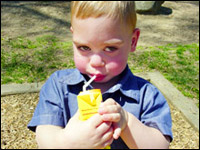Dear Umbra,
I was recently elected the social chairperson of my subdivision’s swim/tennis/social club. Now I’m in charge of party planning for a group of about 150 families. While shopping at Costco, I wondered which is better for the environment: several 128-ounce jugs of apple juice plus many plastic cups, or lots of 6.75-ounce juice boxes that would equal the same juice volume, or the equivalent in 10-ounce plastic bottles? (Glass bottles aren’t really an option because most parties are at the pool, where glass isn’t allowed.) As this is just the first of about 10 parties planned for the year, I’d appreciate your advice for future use.
Samantha Foster
Lilburn, Ga.
Dearest Samantha,
First, let me thank you for your letter. I’m thrilled and daunted to answer a question from a Georgia subdivision mom who shops at Costco. I feel hope for the world, and I hope you find Grist useful.

Which is better, box or bottle?
Now, to your shopping dilemma — and you are far from alone in asking my help with this sort of quandary — just remember the first of the three R’s: reduce. The general idea with any packaging is that less is better. (If you have time between parties, you might want to read a detailed breakdown of why that’s true, put together by the Institute for Lifecycle Environmental Assessment.)
Using this rule of thumb, your large-volume jug with individual cups is the preference. But when you choose the cups, go with paper over plastic. You might also provide pens and encourage people to mark their cups so that they use only one, or even ask people to bring their own cups.
If we could reduce the amount of packaging in the world, it certainly would be lovely, and Costco’s bulk approach is positive in this regard. But there are also other ways to reduce when it comes to grocery shopping. One is to support reductions in agricultural chemicals by buying organic. Another is to reduce “food miles” — jargon for how many miles the food travels from farm to mouth — by buying local products. Typical food mileage in the U.S. hovers around 1,200 (this study from Iowa will give you a taste of how produce travels). If you can find a source closer to your community, you will reduce fuel use and food miles. You’ll also support a local business and keep money within your community.
Sweet Samantha, it can be more expensive — or, at the least, require a bit of legwork — to find local or organic juices. Give it a try, though, if you can. Call your nearest health food store or state cooperative extension office and see what you can find. I know you Georgians grow some nice fruit.
Peachily,
Umbra

